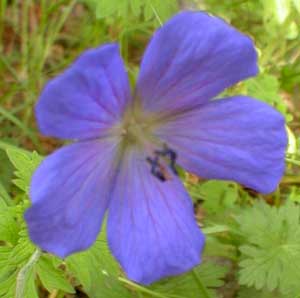
'Johnson's Blue'
Crane's-bill
"Ring a'ring o'geraniums,
A pocketful of uranium,
Hiroshima --
All fall down."
(anonymous?
quoted by Robert Graves in
'The Crowning Privilege')
quoted by Robert Graves in
'The Crowning Privilege')
'Johnson's Blue' Crane's-bill is a hybrid of Geranium himalayense from southwestern China, with the European Meadow Crane's-bill G. pratense. This cross was developed in Holland more than fifty years ago at mid-century.
It will not self-seed in the garden, being a sterile clone. However, & unfortunately, imitation 'Johnson's Blue' cultivars are very commonly sold which often do not bloom as splendidly, & are apt to have fertile seeds, spreading very easily, sometimes weedily.
These imitations have no G. pratense in their makeup, but are G. himalayense or a similar hybrid that are at least blue-flowered. How this common fraud got started I do not know, but I presume 'Johnson's Blue' in its early days, having received the Award of Garden Merit, became extremely popular, therefore its name was misappropriated for slower sellers with similar appearance, & these misidentified strains have continued ever since to be marketed. Retail nurseries are not even aware of the deception, but commercial growers with faux & fertile 'Johnson's Blues' would certainly have to be aware that selling such imitations deceives the public.
Most of us mere gardeners wouldn't be able to tell the difference, but here's a quick-check method of telling whether it is G. himalayense mis-tagged, or an actual 'Johnson's Blue.' The real thing has yellow stamins. The fertile perennial has purple stamins. If it's a misidentified hybrid, however, the difference may not be that obvious.
It is sometimes sold as G. ibericum 'Johnson's Blue.' G. ibericum, a native of Western Asia & the Caucasus, is not the correct designation for a true 'Johnson's Blue,' though G. ibericum does also have large blue flowers. Either this is an often repeated error, or the alternative identification acknowledges certain 'Johnson's Blue' offerings as imitations.
There are far too many fake 'Johnson's Blue' in the marketplace, & I'm nowhere near expert enough to know whether mine's the real deal or not. As it has not self-seeded, it is at least a sterile hybrid. Also ours was for two years a poor bloomer, so I suspect it of being one the many fake 'Johnson's Blue' which are infamous for poor blossom. But we'd planted it in a spot that stretched its tolerances too far to meet its needs, & it did perk up when eventually transplanted to a better location, though not even there has it been as outstanding as 'Johnson's Blue' should be.
Its lighting ideal is morning sun & afternoon shade, in moist well-drained soil. But it adapts to a wide range of sunlight to partial shade conditions, so we had first tried it in dryish shade. After two years in this tough spot, its roots reached some distance from the main clump & sprouted additional small plants. But the leaves were never compact, the clump was stringy, & it never produced more than the occasional token bloom.
Early in its third year, therefore, I finally moved it to a new area prepared for perennials under a tall slender 'King Edward VII' Red Flowering Currant with better watering & dappled afternoon sunlight in humusy soil. It might even now prefer more sun to become impressive, but as the June photo shows, it has been much more rewarding in its improved location.
It has smaller leaves than most of our Crane's-bills, & larger flowers (to two inches wide). These are nearly true blue, & fade to a silvery blue as they age. Ideally 'Johnson's Blue' produces a lot more flowers than most cultivars, beginning in late May & lasting at least through June, with the possibility of reblooms throughout the whole of summer.
It is cold-hardy to zone 5, & with protection possibly to zone 3. Preferably it is given room to spread around a little bit by its wandering underground runners, forming a low groundcover; but alternatively it is easily restrained into a single mounding perennial up to two feet tall & wide.
Grown in the open by itself, it can be too floppy for a specimen plant, but mixes well with other perennials, & looks nice growing around the feet of tall bulbous plants. Early spring bulbs that fade back into by spring's end will not have to leave behind bare ground.